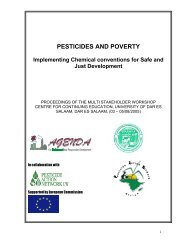Hazardous pesticides and health impacts in Africa - Pesticide Action ...
Hazardous pesticides and health impacts in Africa - Pesticide Action ...
Hazardous pesticides and health impacts in Africa - Pesticide Action ...
You also want an ePaper? Increase the reach of your titles
YUMPU automatically turns print PDFs into web optimized ePapers that Google loves.
Rural communities at risk<br />
Dur<strong>in</strong>g 1999-2001 PAN <strong>Africa</strong> <strong>and</strong> the Ben<strong>in</strong>ois Organisation<br />
for Promotion of Organic Agriculture (OBEPAB) collected<br />
<strong>in</strong>formation on poison<strong>in</strong>g <strong>in</strong>cidents by <strong>in</strong>terview<strong>in</strong>g farm<br />
families <strong>in</strong> several districts <strong>in</strong> Senegal <strong>and</strong> Ben<strong>in</strong>, along<br />
<strong>in</strong>cident report<strong>in</strong>g guidel<strong>in</strong>es developed by the Rotterdam<br />
Convention on Prior Informed Consent. Table 2. summarises<br />
data from the 703 <strong>in</strong>cidents documented, analysed by<br />
gender <strong>and</strong> by age. On average, 16% of the 619 <strong>in</strong>cidents <strong>in</strong><br />
Ben<strong>in</strong> were fatal <strong>and</strong> 23% of the 84 cases <strong>in</strong> Senegal.<br />
No of cases<br />
Twelve different routes by which family members were<br />
poisoned were identified, of which application <strong>in</strong> the field<br />
accounted for 33% <strong>in</strong> Senegal <strong>and</strong> 24% <strong>in</strong> Ben<strong>in</strong>.<br />
Contam<strong>in</strong>ation of food <strong>and</strong> re-use of empty conta<strong>in</strong>ers for<br />
food <strong>and</strong> dr<strong>in</strong>k accounted for 57% of all cases <strong>in</strong> Ben<strong>in</strong> <strong>and</strong><br />
86% of all fatal poison<strong>in</strong>gs, show<strong>in</strong>g how important this route<br />
is <strong>in</strong> putt<strong>in</strong>g families <strong>in</strong> danger (see brief<strong>in</strong>g no.4 <strong>Pesticide</strong><br />
food <strong>and</strong> dr<strong>in</strong>k poison<strong>in</strong>g <strong>in</strong> <strong>Africa</strong> for more details). Other<br />
routes <strong>in</strong>cluded unsafe storage <strong>and</strong> <strong>in</strong>halation <strong>in</strong> rooms,<br />
children play<strong>in</strong>g with <strong>pesticides</strong>, confus<strong>in</strong>g <strong>pesticides</strong> for<br />
other products, <strong>in</strong>appropriate use for treat<strong>in</strong>g headlice or<br />
ticks, as well as 67 suicide attempts <strong>and</strong> 2 cases of murder.<br />
Table 2<br />
Poison<strong>in</strong>g data by gender.<br />
People often assume that poison<strong>in</strong>g risk is highest for those<br />
h<strong>and</strong>l<strong>in</strong>g <strong>pesticides</strong> directly yet the data from Ben<strong>in</strong> <strong>and</strong><br />
Senegal shows that women <strong>and</strong> children feature significantly<br />
even though they generally are not the ones do<strong>in</strong>g pesticide<br />
application. In Ben<strong>in</strong>, children under 10 years old made up<br />
20% <strong>and</strong> 30% of poison<strong>in</strong>g cases recorded <strong>in</strong> 2000 <strong>and</strong><br />
2001. High poison<strong>in</strong>g rates among women <strong>and</strong> children were<br />
also documented <strong>in</strong> Ethiopia, from statistics provided by the<br />
Amhara Regional Health Bureau for 2001 from hospital<br />
records. Women made up 51% of these 185 cases even<br />
though <strong>pesticides</strong> are almost exclusively sprayed by men <strong>in</strong><br />
Ethiopia, while children 5-14 years old accounted for 20% of<br />
cases. Similar frequency of poison<strong>in</strong>gs among women <strong>and</strong><br />
children has been documented <strong>in</strong> recent studies <strong>in</strong> Ecuador 4<br />
<strong>and</strong> <strong>in</strong> India 5 , emphasis<strong>in</strong>g that pesticide-related ill <strong>health</strong><br />
can seriously affect farm families <strong>and</strong> rural communities, yet<br />
government risk assessment generally only considers<br />
scenarios for male spray operators.<br />
No of cases<br />
Table 2b - Poison<strong>in</strong>g data by age.<br />
Widespread use of hazardous <strong>in</strong>secticides <strong>in</strong> the home,<br />
unsafe storage <strong>in</strong> kitchens <strong>and</strong> bedrooms, dangerous<br />
treatment of gra<strong>in</strong>s <strong>and</strong> beans <strong>and</strong> use of empty <strong>in</strong>secticide<br />
conta<strong>in</strong>ers all contribute to these tragic figures. Wash<strong>in</strong>g<br />
pesticide-contam<strong>in</strong>ated work cloth<strong>in</strong>g poses another risk.<br />
Us<strong>in</strong>g <strong>in</strong>secticides for home ‘remedies’ is especially<br />
dangerous- <strong>in</strong> Ethiopia, farmers used highly toxic<br />
<strong>in</strong>secticides to treat headlice, fleas <strong>and</strong> bedbugs, <strong>and</strong> even<br />
to try <strong>and</strong> cure open wounds, us<strong>in</strong>g malathion or DDT,<br />
sometimes with fatal results. Farmers expla<strong>in</strong>ed that it was<br />
the poorest people who resorted to this potentially lethal<br />
‘cure’. Easy availability of such hazardous chemicals <strong>in</strong> rural<br />
areas contributes to <strong>in</strong>creased suicide rates, particularly of<br />
women <strong>and</strong> teenage girls, mentioned as a grow<strong>in</strong>g worry by<br />
farmers <strong>in</strong> Ethiopia, <strong>and</strong> cotton farmers <strong>in</strong> Senegal <strong>and</strong><br />
Ben<strong>in</strong>.<br />
%<br />
60<br />
Table 2c - Number of fatal cases/total<br />
cases
















